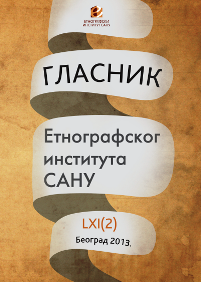Тело духовно – концепт (словенске) душе (I)
The Spiritual Body – Concept of the (Slavic) Soul (I)
Author(s): Ivana BašićSubject(s): Anthropology
Published by: Етнографски институт САНУ
Keywords: concept of the soul; lexical iconicity; Slavic culture; ‘duša'.
Summary/Abstract: This work analyses the concept of the soul in the Slavic and the Serbian cultures in the context of general views on soul and concludes that the dual conception body-soul did not exist in the pagan Slavic world picture. It was developed in Slavic and Serbian culture along with the acceptance of Christianity, while the earlier, pagan culture held in a higher esteem the notion of the vegetative and emotive soul, closely related to the body and the idea of free soul – man’s double, who, nevertheless, implies a certain, although immaterial and not always apparent embodiment (“spiritual body” – ‘telo duhovno’). The iconicity of the lexeme ‘duša’ rests upon the opposition visible-invisible, which is reserved for the vegetative or organic soul, while the free soul depends on the opposition material-immaterial. The difference in the iconicity of the lexemes ‘duša’ (“soul”) and ‘duh’ (“spirit”) – although both stand in an etymological relation to ‘dah’ (“breath”), ‘disati’ (“to breath”), ‘duvati’ (“to blow”) – lies in the fact that ‘duh’ is conceptualized as a divine breath, ‘sila duhovna’ (“a divine force”), which can be individuated in part, but which maintains the characteristics of its divine or demonic origin and is related to the intellect and the will, elements of air and fire, while the ‘duša’ is individuated and linked to “lower” levels of human being – bodily functions and sensitivity related to the element of water.
Journal: Гласник Етнографског института САНУ
- Issue Year: LXI/2013
- Issue No: 2
- Page Range: 113-129
- Page Count: 17
- Language: Serbian

